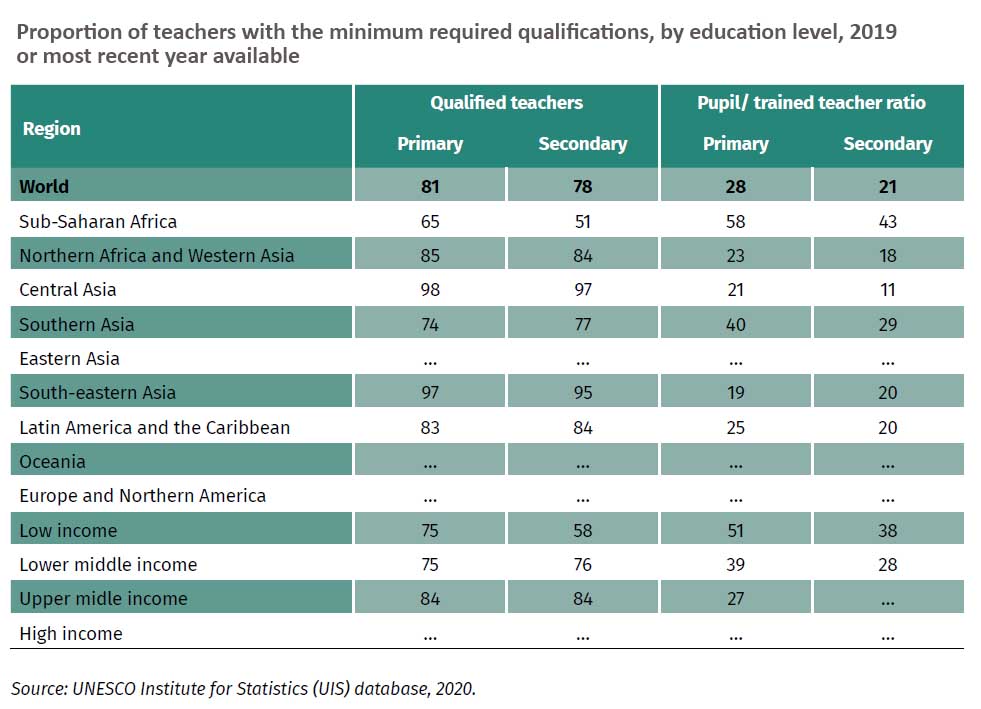This is a blog drawing on the conclusions of the 2020 World Teachers' Day fact sheet published by the International Task Force on Teachers for Education 2030, UNESCO Institute for Statistics and the Global Education Monitoring Report.
COVID-19 has closed schools around the world, separating students from their teachers and classmates. Even as many teachers attempt a return to some normality, reopening schools and reintegrating students brings its own challenges.
This World Teachers’ Day (October 5th), we are taking stock of some of the challenges facing teachers and identifying what needs to be done to help them provide quality education for all.
The world needs more teachers
‘Quality education’, the fourth UN Sustainable Development Goal, has never been more important. For all the disruption, the pandemic is also an opportunity. By focusing on educating and energising younger generations, societies can plan a route out of COVID-19 that leads to a better world.
For this we need more qualified teachers. There are already 28 million more teachers worldwide than there were 20 years ago, but this does not meet the demand for the 69 million teachers previously estimated to ensure universal primary and secondary education by 2030. The need is greater in disadvantaged regions. For example, 70% of countries in sub-Saharan Africa have teacher shortages at primary level, with an average of 58 students to every qualified teacher. Compare this with South-eastern Asia where the average ratio is only 19 students to every teacher.
Levels of teacher training also differ greatly between global regions: 65% of primary teachers in sub-Saharan Africa have the minimum qualifications required trained, compared with 98% in Central Asia.

It is a complex conundrum: education is the best way for disadvantaged societies to redress global inequalities, but they are fundamentally handicapped, with neither the capacity nor teacher training to give every student the support they need.
Who teaches the teachers?
There are some concrete proposals that aim to increase the level of support teachers receive. The African Union, for example, has developed universal standards for teacher qualifications that will ensure all teachers are equipped with the knowledge, skills and values they need. This means those teachers will be better prepared when they enter the classroom, and this, coupled with wider recruitment to decrease classroom sizes, can greatly improve the quality of education systems in the region.
COVID-19 has forced a transition to remote and online learning. Teachers therefore urgently need better training in information and communication technology (ICT). Yet research shows that only 43% of teachers in OECD countries feel prepared to use ICT to deliver lessons. Help is coming, but again the pandemic shines a light on global inequality as too many homes in low-income countries lack the devices and connectivity to learn online. Teacher in low income countries also struggle given that only 41% of them receive teachers practical ICT guidance, compared with 71% in high-income countries.
Look to the leaders
Leadership training can mitigate the worst disparities of COVID-19, empowering individual teachers to lead their colleagues through this difficult time.
Strong leaders create a culture of trust in schools, instilling a collective sense of responsibility, and offering support and recognition. For example, Professional Learning Communities (PLCs) are forums where teachers can support one another’s training and development. In Rwanda, 843 school leaders, having completed a diploma in school leadership, are using PLCs to share the benefit of their training with colleagues. In South Africa, school leaders are encouraged to set up PLCs and use them to induct novice teachers into the profession, giving them the confidence to take responsibility for their own professional development. And in Ecuador, 287 school leaders participate in PLCs to exchange best practices and organise themselves into a supportive network.
What else do teachers need?
Better training and strong leadership within schools will benefit global education systems for years to come. But another issue made more urgent by the pandemic is inclusivity. As students return to school, the ability of teachers to promote an inclusive environment is a vital skill to mitigate disruption and ensure students aren’t excluded from learning.
61% of countries from a recent survey claim to train their teachers on inclusivity skills, but very few guarantee such training in their policies or laws. However, the pandemic has already done enough to distance teachers from their students and students from each other. With many schools still observing physical distancing to slow the spread of the virus, specific training in inclusive teaching is necessary to ensure a cohesive and effective learning environment.
Much work done, much still to do
Teachers must be given guidance and professional development opportunities to ensure they feel equipped to hold their classrooms together, physically or virtually. In many parts of the world, this is sorely lacking.
Work is underway to improve the situation. New standards are being set, training is being implemented, and everywhere strong leaders are creating inclusive, supportive learning environments. For true progress to be made however, governments must listen to teachers and teacher unions. Real change can only happen if teachers' voices are heard. Teachers and policymakers need to navigate this new world together.
Consult the 2020 World Teachers' Day fact sheet published by the International Task Force on Teachers for Education 2030, UNESCO Institute for Statistics and the Global Education Monitoring Report.
This blog is part of a series of stories addressing the importance of the work of, and the challenges faced by teachers in the lead up to this year’s World Teachers’ Day celebrations.
*
Cover photo credit: GPE/Kelley Lynch